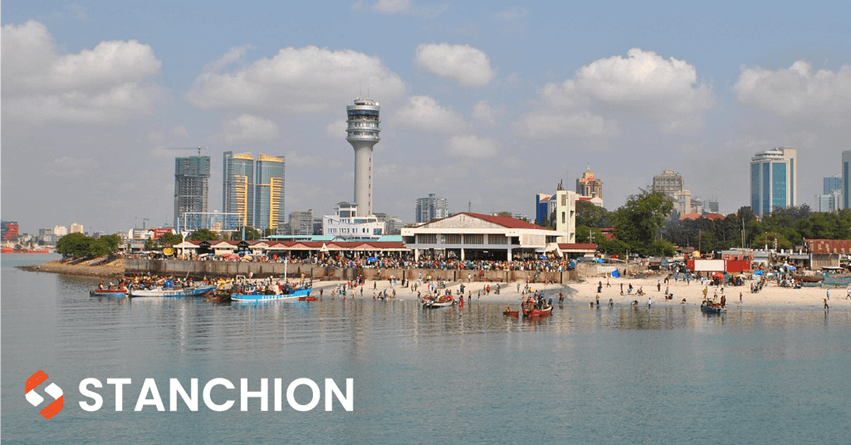Tanzania’s Payments Evolution: Mobile Money Providers Lead Banks to a Digital Issuing Future
Stanchion recently exhibited at the Seamless East Africa event in Nairobi, Kenya. While in the region, we took a trip to Tanzania to better understand the market in terms of its development for digital payment experiences and what banks are driving.
Despite being a neighbouring country to Kenya with several similarities such as the popularity of mobile money, there are also differences. The government has taken a progressive approach to encouraging inbound foreign tourism, and a few years ago reduced the tax on the importation of NFC-enabled smartphones, making it a substantially larger market for NFC-device ownership than its neighbours, an opportunity that the mobile operators have capitalised on and are innovating around.
Whilst many might think that the capital of Tanzania is the largest and most populous city – Dar es Salaam, with circa 8.5m people and growing at 5% annually, this in fact is not the administrative and official capital, which is Dodoma.
Tanzania is one of the most populous African nations at 70 million people, making it the 21st largest country in the world and 5th largest in Africa, with a low per capita GDP of US$1,150.
The article below aims to give the reader a sense of what is happening in Dar es Salaam, the economic hub of Tanzania in terms of both economic development and the local payments industry. To learn more please read on.
Dar es Salaam the Economic Engine of Tanzania and Her Digital Future
Dar es Salaam is Tanzania’s economic powerhouse, a port city with a rich heritage and now a large commercial metropolis.
Once a small fishing village, the city began its transformation in the 1860s when Sultan Majid bin Said of Zanzibar initiated construction of Dar es Salaam (meaning “House/Abode of Peace”). In 1887, under German colonial rule, it became the administrative capital of German East Africa — attracted by its deep-water port, essential for trade and administration. Infrastructure such as the Central Railway Line laid the foundations for industrial and urban growth. Following World War I, the British took over, continuing Dar es Salaam’s role as a hub for administration and commerce, encouraging migration and economic diversification.
Between 9 December 1961 (Tanganyika independence) and 10 December 1963 (Zanzibar independence) and then 26 April 1964, when the two merged to create the newly independent United Republic of Tanzania, Dar es Salaam emerged as a melting pot of African, Arab, Indian and European influences, to become the country’s financial and cultural nerve centre. A position it still retains today.
Tanzania’s Vision 2025 Economic Growth Plans
Driven by Vision 2025, Tanzania’s government is progressing towards a modern, industrialised economy:
- GDP Growth: Economic growth reached 5.4% in 2024 and is projected at 6% for 2025.
- Budget Expansion: For 2025/26, the government increased its budget by 13.4% to circa US$22 billion, prioritising infrastructure, social services and economic competitiveness.
- Key Sector Investments: Are in energy production, transport modernisation, telecommunications, education and healthcare. Emphasis is additionally placed on industrialisation, value addition in agriculture, stimulating manufacturing and tourism, with this sector up 84% to >4.25m tourists annually.
While not specified as a focus, the government has been actively supporting digitalisation, and this is being felt in the mobile money sector and now rippling out into broader retail financial services.
The Cash-lite Revolution iIgniting the Rise of Digital Financial Services
There has been a dramatic shift in recent years, changing how businesses and individuals transact:
- Mobile Money Dominance: Over 55.8 million mobile money accounts exist. About eight out of ten Tanzanians actively use this for their mobile financial services and therefore as a means of financial inclusion.
- Instant Payments System: The Tanzania Instant Payments System (TIPS) serves as the backbone of interoperable retail payments. This connects 45 digital payment providers nationwide. In 2024, TIPS processed retail transactions valued at TZS15.17 trillion (USD 6.13 billion) steadily deepening financial inclusion and end-user benefits.
- POS and Merchants: In 2024, the Bank of Tanzania (BoT) introduced policies to make digital payments more affordable. For example, eliminating card payment charges at POS terminals, making card-based payments (debit, credit, prepaid) fee-free for consumers at POS across the country. Merchants are prohibited from imposing extra fees, further incentivising the use of cards and digital payments.
- Efficient Bulk Processing: EFTs and digital payment switches are favoured for their security, speed and cost-efficiency, especially for retail, corporate and government payments.
Tanzania hosts a growing fintech festival, which was held in June this year. This suggests that increased competitiveness will soon come into the market, and this may further wake up the banking sector, which has also seen the mobile operators change the issuing market with their virtual card issuance programmes.
Card Issuing and the Growth of Virtual Card Usage
In Tanzania, card usage is on the rise, with both physical and virtual options available, although most of the digital retail payments are still dominated by mobile money. Nevertheless, thousands of industries, SMEs and individuals are integrating cards for business and commerce.
Major banks, fintechs and mobile operators (notably Vodacom’s M-Pesa) issue physical and virtual cards — including VISA and Mastercard options. These enable online payments, international purchases, expense management and integration with digital wallets.
It is the area of virtual card issuing that has seen the most innovation and most competition in Tanzania. The mobile operators having seen the success in Kenya from M-Pesa quickly launched the offering locally. Outside the Telco’s the adoption is still early and in a niche stage, especially among banks and fintechs, with Miden and Fyatu being examples of fintechs already issuing such cards.
Approximately 820,000 virtual cards have been issued valued at more than TZS 220 billion (USD 84.8 million). These virtual cards are used mainly by businesses for expense management, online subscription payments, ad spend, B2B payments and cross-border transactions. “GDP of US$1,150”. Some xPay (Google Pay, Apple Pay, etc…) consumers also use the virtual cards for subscription spend like Netflix. These have come with downsides such as high transaction decline rates.
Across the East African region, Kenya leads the way on virtual card issuance, whilst Uganda and Rwanda, which also have growing fintech sectors, also have increasing virtual card issuance. In Rwanda, initiatives are underway to allow fintechs to issue virtual cards, deploy tokenisation and integrate digital wallets with mobile payments, signalling regional expansion of this trend.
Of the 12 million physical cards issued in Tanzania, 96% of card transactions are for ATM withdrawals processed through the national Umoja switch, with limited use at points of sale (POS) or online. Mobile money remains the dominant payment method for everyday transactions, retail, transport and fuel sectors, where card payments continue to struggle to gain footholds. Locally, there is also the N-Card, offering a hybrid showcasing tailored local solutions integrated with mobile money.
With no current sight of a major xPay Wallet getting regulatory approval to enter the market, tokenisation hasn’t taken off yet. In scenarios like this, the largest banks by market share will often launch their own bank issuer wallet tokenisation projects, but it’s often the case that tokenisation and therefore tap to pay from phone is reliant on the central bank giving regulatory clearance to a major xPay Wallet, so it’s still a case of watch this space!
Cryptocurrency and Future Prospects
As Tanzania embraces fintechs and modernises its payments and financial ecosystem, it aims to stay alert to disruptive financial technologies like cryptocurrencies and digital currencies. The courts have recognised the legality of electronic transactions involving crypto — even though formal regulations remain “in development”. This signals future openness to new digital payment forms.
Powering Tanzania’s Payments Evolution with Stanchion
Tanzania’s payments ecosystem has already been disrupted by mobile money and now by the mobile operators launching scheme-backed virtual cards. Some of the banks have started offering customers improved self-service capabilities within their bank apps, but overall, the banks have a challenge to accelerate the pace at which they launch digital products for their customers.
The largest banks in terms of market share will need and are already working to offer increased digital experiences to their customers but for many of the circa 50 banks in the market, the opportunity rests in them being able to find solutions to deploy new product offerings faster.
Virtual Cards offer a low-cost way of levelling the competitive gap that has opened up, and with a growing eCommerce market, the virtual cards are ideally placed to be used by the younger generation. With the government also keen to eradicate plastic to aid the environment and tourism, educating the customer on virtual cards, tokenisation represents a way to reduce the cost of physical card issuing.
This is where Stanchion’s Payment Fabric can provide mid-size Tanzanian banks with a key advantage. Our modular and adaptive technology bridges the gap between legacy banking infrastructure and next-generation digital payment experiences. By enabling seamless integration across banking platforms, card networks and digital wallets, we empower financial institutions to innovate at speed, optimise costs and deliver the frictionless digital experiences that modern consumers expect.
With a global footprint and deep Africa market expertise, Stanchion is uniquely positioned to support this transition — helping banks build scalable, future-ready payment ecosystems that align with Tanzania’s mobile-first economy.



